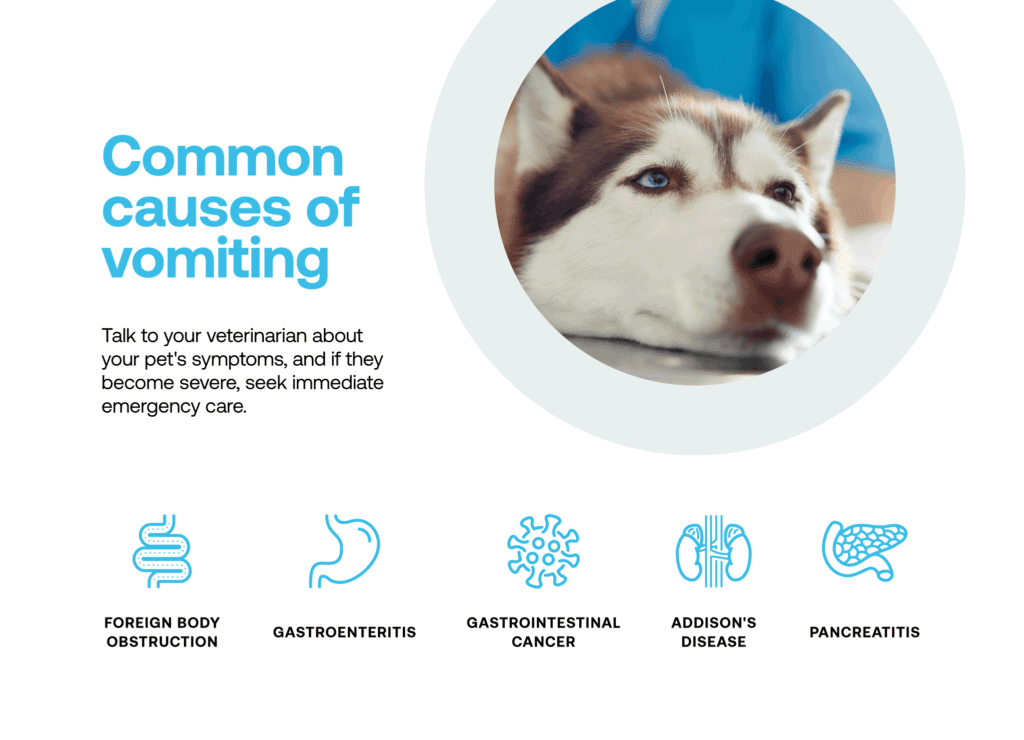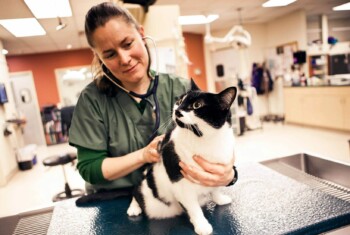Vomiting is the active process of bringing up food or fluid from the gastrointestinal (GI) tract. If your pet is vomiting, you may be concerned about the cause and wondering what to do next.
Cats and dogs may vomit for many reasons, ranging from something simple like eating something that didn’t agree with them to a more complex or serious illness.
Fortunately, there are some steps you can take at home to learn about potential causes and decide whether or not to seek veterinary care.
What causes vomiting in dogs and cats?
Sometimes vomiting is hard to diagnose, because it can look similar to deep productive coughing or be mistaken for regurgitation.
True vomiting is a conscious process where the pet experiences nausea (sometimes salivates), followed by several abdominal contractions that result in bringing up material. In comparison, regurgitation is a passive and often silent process where gastrointestinal contents are spit up without effort.
There are many potential causes of vomiting in pets, which can have varying levels of medical severity and urgency. Common causes of vomiting include:
Foreign body obstruction.
Foreign body obstruction occurs when the GI tract becomes blocked by an object or substance your pet ingested. This is one of the more common causes of acute vomiting in young dogs and cats, especially if they tend to play with toys, socks or other objects that might be unraveled or swallowed.
Pets experiencing foreign body obstruction may also show signs of anorexia, depression, dehydration or abdominal pain – which often looks like crying, refusal to lie down or assuming a hunched position.
Foreign body obstruction is an emergency that requires a combination of medical and sometimes surgical treatment. If you suspect your dog ingested a foreign body, take them to your nearest pet hospital.
Gastroenteritis.
Gastroenteritis refers to sudden vomiting and diarrhea in pets, typically caused by inflammation, irritation or infection of the GI tract. It’s one of the most common veterinary emergencies.
Acute gastroenteritis can result from dietary indiscretion, intestinal parasitism, or intolerance to a substance your pet ingested even if it’s in small amounts.
The signs of gastroenteritis can vary in severity, with some animals having signs that resolve on their own, to others that require outpatient or hospitalized treatment. Because the treatments for these conditions also differ, it’s important to seek veterinary care to obtain an accurate diagnosis.
Gastrointestinal cancer.
Gastrointestinal cancer (cancer of the stomach or intestines) is a rare cancer that affects dogs and cats, typically of older age. Vomiting (sometimes with black or blood-tinged contents), loss of appetite, diarrhea and weight loss are some of the signs that can be seen with this condition. Diagnosis can be challenging since visualizing the inside of the GI tract or doing an abdominal ultrasound are advanced skills, so if x-rays and lab work don’t provide conclusive information, referral for ultrasound and possible endoscopy would be the next steps.
Pancreatitis.
Pancreatitis refers to inflammation of the pancreas, a glandular organ that secretes enzymes into the digestive tract to aid with food processing. The pancreas can become inflamed for a variety of reasons, including an intolerance to a food, a genetic predisposition, reaction to a medication, traumatic injury, systemic illness, or even secondary to primary gastrointestinal disease. It can be acute or chronic in nature, and many animals may have recurrent flare-ups of acute disease or persistent low-grade chronic pancreatitis. Cat pancreatitis is more likely to be “idiopathic,” which refers to cases in which the cause is unknown.
Other signs associated with pancreatitis in dogs include anorexia, depression and diarrhea.
Addison’s disease.
Affecting primarily dogs, Addison’s disease is a disease of decreased production of adrenal gland hormones. This can include the salt-regulating hormones (mineralocorticoids), the stress-response hormone (cortisol) or both.
The signs of Addison’s disease can come on quickly – in the timespan of just a few days – or they can develop over the course of weeks or months. This disease is often called “the great pretender” since it can have anything from vague signs of malaise to dramatic signs of cardiovascular shock and collapse. Fortunately, it is relatively simple to diagnose once the clinical suspicion exists.

Other causes of vomiting.
Although the GI disturbances listed above are the most common causes of vomiting in dogs and cats, it’s important to remember that it can also be a symptom of non-GI illness. Pets with diabetes and other endocrine diseases, electrolyte imbalances, organ failure, toxicities, etc. can all have vomiting as a symptom and should be evaluated if it persists.
When to seek veterinary care for vomiting in pets.
If your dog or cat vomits multiple times in one day or for two or more days, it’s a good idea to call your veterinarian.
Vomiting can indicate a medical emergency when it’s severe or when it’s present with other symptoms. If your pet is experiencing any of these additional signs, seek immediate veterinary attention:
- Loss of appetite
- Increased or decreased thirst or urination
- Blood in vomit or stool
- Lethargy
- Diarrhea
- Collapse
- Pale or white gums
- Abdominal pain
- Weight loss



